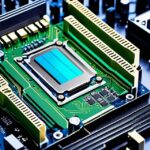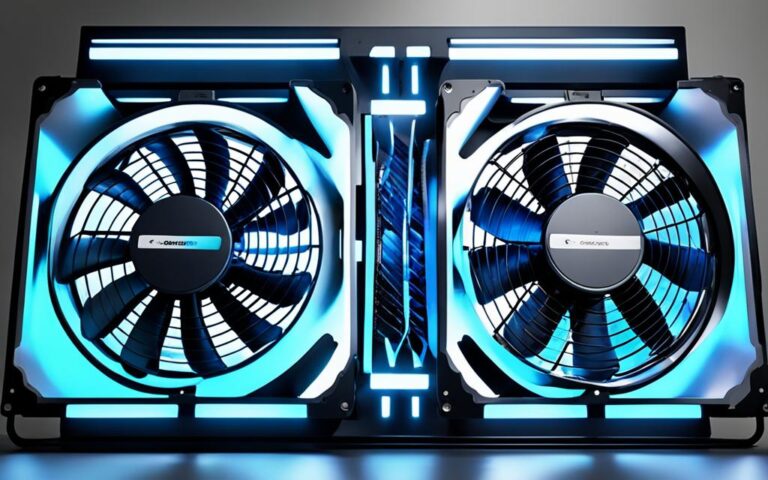The 48-bit Ethernet address, also known as the Media Access Control (MAC) address, is a unique identifier for your computer’s network interface card (NIC). It’s crucial for smooth internet connections.
This address has six groups of two letters and numbers, separated by dots or hyphens. For instance, the address 00:0c:29:b4:cb:201 shows how it looks. Each part tells us about the device’s maker and type.
Data moves around the internet in Ethernet frames. These frames have fields like source and destination addresses, and the type of data. The destination address tells the network where to send the data. In our example, it’s a0:f3:c1:f8:6d:f9, which is a TP link router’s address1.
The frame type field shows what kind of data is inside. In this case, it’s IP data, marked as 0x08001. This tells us the frame is carrying internet data.
It’s key to remember that the Ethernet source address, a0:f3:c1:f8:6d:f9, belongs to a router, not your computer or gaia.cs.umass.edu1. This address shows who sent the data.
Key Takeaways:
- Your computer’s 48-bit Ethernet address is a unique identifier assigned to the network interface card (NIC).
- The Ethernet address is made up of six groups of two hexadecimal digits.
- Ethernet frames consist of various fields, including source and destination addresses, frame type, and data.
- The destination address in an Ethernet frame directs the data to its intended recipient.
- The frame type field indicates the type of data carried in the Ethernet frame.
What is a 48-bit Ethernet Address?
A 48-bit Ethernet address, also known as a MAC address, is a unique ID for devices on a network. It’s given to a computer or device’s network interface card by the maker. This ID can’t be changed by the user.
This address has six groups of two digits, making it 48 bits or 6 bytes long. It’s sent with every packet of data. This makes it a unique identifier for the device.
The Ethernet address can look different, like with digits separated by a colon or dash. But, these changes don’t affect how the address works.
Finding the Ethernet hardware address varies across different systems:
- For Apple Macintosh:
- On Mac OS X 10.3 and later, go to System Preferences > Network > Ethernet tab to see the Ethernet hardware ID.
- For Mac OS X 10.2, go to System Preferences > Network > TCP/IP tab to find the Ethernet Hardware ID.
- For Microsoft Windows:
- To see the Ethernet hardware address, open cmd, type ipconfig /all, and look for the Physical Address under Ethernet adapter.
- For Linux/UNIX:
- Find the HW Address by typing /sbin/ifconfig in the command prompt. Look for the Physical Address under HWaddr section.
How to Find Your Computer’s 48-bit Ethernet Address
Every device on a computer network has a unique 48-bit Ethernet address, also known as the MAC address. It’s vital for networking tasks and troubleshooting. Here’s how to find it:
- Start by accessing your computer’s network settings, which can usually be found in the control panel or system preferences.
- Look for the network adapter or Ethernet connection settings. This is where you’ll find information related to your computer’s network connection.
- Within these settings, you should be able to locate the MAC address or Ethernet address. The MAC address is a 48-bit identifier made up of six groups of two hexadecimal digits, separated by colons or hyphens.
The Ethernet address is a unique identifier for your computer in a network. It’s like a signature or fingerprint that distinguishes your device from others. The MAC address is sent with every packet of data your computer sends and receives. This lets the network know how to route the data2.
The 48-bit Ethernet address is set during manufacturing and can’t be changed. It’s unique to every device2.
Steps to find the Ethernet address vary by operating system. Here are a few examples:
– For Mac OS X 10.3 and later: Go to System Preferences and find the Built-in Ethernet tab to see the Ethernet hardware address2.
– For Microsoft Windows: Open the command prompt and type “ipconfig /all”. The Physical Address entry will show your Ethernet hardware address2.
– For Linux/UNIX systems: Use the “/sbin/ifconfig” command in the terminal. Your Ethernet hardware address, shown as HWaddr, will appear2.
By following these steps, you can easily find your computer’s 48-bit Ethernet address. This ensures smooth network connectivity and helps with troubleshooting. Knowing your MAC address is key for tasks like setting up secure connections or access controls2.
Importance of the 48-bit Ethernet Address
## Importance of the 48-bit Ethernet Address
The 48-bit Ethernet address is key for identifying devices on a network and keeping it secure. It makes sure every device has its own ID, avoiding mix-ups and ensuring smooth communication. This address, known as the MAC address, is given to each network card. It has two parts: the first 24 bits show who made the card, and the last 24 bits pinpoint the card itself3.
This address is vital for network security. It helps control who can join the network by device ID. By setting rules based on these IDs, network managers can keep out unwanted devices. This shields the network from threats and keeps it safe4.
Also, the 48-bit Ethernet address is crucial for fixing network problems. By finding a device’s unique ID, network experts can pinpoint and fix issues faster. This means less time wasted and less network downtime4.
Moreover, it’s key for managing network resources. Devices can be tracked and resources can be given out based on their IDs. This helps in giving IP addresses and managing traffic for better network performance and smooth running5.
In summary, the 48-bit Ethernet address is vital for identifying devices, securing networks, solving problems, and managing resources. Its unique features and security role make it a must-have in today’s networks53.
| Importance of the 48-bit Ethernet Address |
|——————————————|
| Key Points |
| – The 48-bit Ethernet address is a unique identifier for each device connected to a network. |
| – It prevents conflicts and ensures seamless communication. |
| – The MAC address plays a vital role in network security, troubleshooting, and resource management. |
| – It allows for access control and protection against unauthorized devices. |
| – Network administrators can use the MAC address for device tracking and resource allocation. |
The Format of a 48-bit Ethernet Address
The 48-bit Ethernet address, also known as the MAC address, is a unique ID given to each network interface card (NIC) when made. It looks like six groups of two hexadecimal digits, separated by either colons or hyphens.
“The 48-bit Ethernet address is a crucial component of network communication, acting as a digital fingerprint for each device.”
The MAC address has twelve characters in total, with each pair making up a byte of the address. The digits range from 0 to 9 and A to F. A represents the decimal value of 10, B represents 11, and so on.
For example, a typical MAC address could be 00:1A:3B:4C:5D:6E. Each pair of digits forms one byte, making a total of 48 bits. This address is the unique ID for the network interface card.
When sending data, the Ethernet card sends its MAC address with every packet. This lets other devices on the network know how to send the information.
It’s worth noting that leading zeros in the Ethernet address are usually dropped. For instance, ’00’ can be represented as simply ‘0’.
Representing the 48-bit Ethernet Address
There are a few ways to show the 48-bit Ethernet address. The most common ways include:
- Using colons: 00:1A:3B:4C:5D:6E
- Using hyphens: 00-1A-3B-4C-5D-6E
- Using periods: 00.1A.3B.4C.5D.6E
- Running the digits together: 001A3B4C5D6E
- Adding spaces between groups: 00 1A 3B 4C 5D 6E
Finding Your Computer’s 48-bit Ethernet Address
To find your computer’s 48-bit Ethernet address, you can use different methods depending on your operating system:
- On Apple Macintosh operating systems, you can find the Ethernet hardware address in the Network preference pane under System Preferences.
- On Microsoft Windows operating systems, you can get the Ethernet address by running the command
ipconfig /allin the command prompt. - Linux/UNIX users can find the Ethernet hardware address by using the command
/sbin/ifconfigin the command prompt.
The Importance of the 48-bit Ethernet Address
The 48-bit Ethernet address is key to network communication. It makes sure data packets go to the right place and helps devices talk to each other on a local network.
Knowing how the 48-bit Ethernet address works is important for fixing network problems and keeping devices running smoothly.
A MAC address is a unique ID given to each network interface card (NIC) during manufacturing.
| Statistical Data | Value |
|---|---|
| Computer’s 48-bit Ethernet Address | 00:22:5f:99:b6:64 |
| Router Address in Ethernet Frame | 00:1f:6c:be:cf:bf |
| Frame Type Field (Hexadecimal) | 0x0800 |
| Position of “G” in “GET” | 52 bits |
| Source Address in Ethernet Frame (Router) | 00:1f:6c:be:cf:bf |
| Destination Address in Ethernet Frame (Computer) | 00:22:5f:99:b6:64 |
| Source Address in ARP Request Frame | 00:22:5f:99:b6:64 |
| Destination Address in ARP Request Frame | ec:1a:59:0b:4f:94 |
| Frame Type Field in ARP Frame (Hexadecimal) | 0x0806 |
| Position of ARP Opcode Field | 20 bytes |
| Value of Opcode in ARP Request Frame | 0x0001 |
| Sender IP Address in ARP Message | 192.168.1.105 |
| ARP Reply Source Address | ec:1a:59:0b:4f:94 |
| ARP Reply Destination Address | 00:22:5f:99:b6:64 |
Based on the provided statistical data6, the 48-bit Ethernet address is a crucial element in network communication. Its unique format consisting of six groups of two hexadecimal digits allows for the identification and routing of data packets on a network.
Finding the Destination Address in an Ethernet Frame
The destination address in an Ethernet frame is key for network communication. It tells the MAC address of the device that should get the frame7.
To find the destination address, look at the Ethernet frame’s structure7.
The Ethernet frame has many fields, including the destination MAC address field7.
In the frame, the destination MAC address is a 48-bit identifier. It’s given to the device meant to receive the data789.
This MAC address is shown as six pairs of hexadecimal digits, separated by colons79.
For example, a destination MAC address could be “00:1A:6B:12:34:56”9.
By looking at the destination MAC address field, you can see who the data is for7.
Unicast MAC addresses send data to just one device7.
Broadcast MAC addresses, like “FF:FF:FF:FF:FF:FF”, send frames to all devices on the network7.
Multicast MAC addresses are for sending multicast packets. For IPv4 multicast, they start with “01-00-5E”. For IPv6 multicast, they start with “33-33”7.
The destination address is vital in an Ethernet frame. It makes sure data goes to the right place7.
By looking at the Ethernet frame and the destination MAC address, devices can send data to the right place. This makes communication smooth7.
- Cisco Press – Understanding Ethernet MAC
- Stack Overflow – Difference between a Physical Address and MAC Address in
- ScienceDirect – Ethernet Address
Understanding the Frame Type Field in an Ethernet Frame
The frame type field in an Ethernet frame is key to knowing which upper layer protocol is used10. It’s a two-byte hexadecimal value that tells which protocol should process the data inside11. This field is often shown in hexadecimal, like 0x0800 for IP (Internet Protocol)11. It helps devices figure out how to handle the data in the frame11.
This field is vital for Ethernet frames, making sure devices and networks communicate well10. It decides how the data gets to its destination11. When a device gets an Ethernet frame, it looks at this field to know which protocol to use for the data11.
For example, a value of 0x0800 means IPv4 (Internet Protocol version 4) is used11. The device then uses the right upper layer protocol to understand the data11. This makes sure devices talk to each other using IP over Ethernet smoothly11.
The frame type field in Ethernet frames also gives clues about the network setup11. Tools like Wireshark use this field to find out the upper layer protocol and help fix network problems11. Wireshark can also find out who made the sender and receiver devices by looking at their MAC addresses11.
This field is crucial for understanding and fixing Ethernet frames, helping network experts manage and troubleshoot10. By looking at this field, checking MAC addresses, and decoding the protocol, we can see how data is sent and find problems11.
Knowing about the frame type field in Ethernet frames is key to understanding how networks work10. By using this field correctly, network pros can make sure data moves across Ethernet networks well11.
Exploring the Contents of the ARP Cache
The ARP cache is key in network communication. It stores IP and MAC address mappings. Each entry has an IP address, its MAC address, and the protocol type12. The cache updates constantly as devices talk to each other.
IP addresses help devices identify each other for data transfer12. MAC addresses are unique to each network card12. The ARP cache uses these to quickly find a MAC address for an IP address12. This makes network communication smooth.
When a device sends data, it checks the ARP cache for the MAC address of the destination12. If not found, it sends an ARP request to the network12. The device with the IP address replies with its MAC, which gets stored in the cache for later use12.
The ARP cache has a limited size, meant for the most used mappings12. Entries are usually short-lived, making way for new ones12. This keeps the cache fresh and accurate for network changes12.
ARP Spoofing is a big threat, where fake ARP messages link a criminal’s MAC to a legitimate device’s IP12. This lets the criminal steal or alter data, risking the network12.
Man-in-the-Middle (MITM) Attacks also pose a risk, by intercepting and changing messages12. An attacker can use the ARP cache to redirect traffic, eavesdrop, or inject malware12.
Denial-of-Service (DoS) and Distributed Denial-of-Service (DDoS) attacks flood networks, blocking access to resources12. They exploit network weaknesses, including the ARP cache, to disrupt operations12.
Knowing about the ARP cache is vital for network security and upkeep12. It helps network admins and IT pros tackle risks and protect the network12.
ARP Request and Reply in the Ethernet Frame
An ARP request13 message is sent to find the MAC address of a specific IP address. This request is wrapped in an Ethernet frame. It has the source and destination MAC addresses and marks it as an ARP frame. The device that gets the ARP request makes an ARP reply13 with the needed MAC address and sends it in another Ethernet frame. This way, devices can map IP addresses to MAC addresses for communication.
ARP is key for network communication. It helps turn IP addresses into MAC addresses and back. Link 113 statistics show how ARP works in Ethernet frames.
The Ethernet frame with an ARP request has the sender and receiver’s addresses. The destination address is a broadcast address (ff:ff:ff:ff:ff:ff)14. The frame type field is set to 0x0806, showing ARP is used to match IP addresses with MAC addresses.
The ARP opcode field in the frame is 0x0001 for a request15. This tells us it’s a request, not a reply. The ARP message15 also has the sender’s IP address, helping devices communicate by IP.
In the ARP reply frame, the ARP opcode field is 20 bytes from the start14. It’s set to 0x0002 for a reply15. The reply gives the MAC addresses of both the sender and the receiver. This info helps set up correct address mappings in ARP caches. The frame type field stays at 0x0806, showing ARP is the protocol used.
Knowing how ARP requests and replies work in Ethernet frames is crucial for network efficiency and troubleshooting. These details1315 show ARP’s role in mapping MAC addresses. ARP helps devices turn IP addresses into MAC addresses, making data transfer smooth and network connectivity strong.
Conclusion
The 48-bit Ethernet address, also known as the MAC address, is key in computer networking. It acts as a unique ID for devices on a network. This makes communication smooth and helps manage the network well16.
A MAC address is a 12-digit number in hexadecimal, made up of 48 bits. With so many possible combinations, each MAC address is unique. This helps tell devices apart and manage network traffic17. MAC addresses are crucial for identifying devices, sending data, and keeping networks secure17.
The Address Resolution Protocol (ARP) helps turn hardware addresses into IP addresses. This is vital for network operations18. With more devices online, especially IoT ones, the need for IP addresses is growing18.
In summary, knowing about the 48-bit Ethernet address and its links to MAC and IP addresses is crucial. It helps users fix network problems, use resources better, and keep connections secure161718.
FAQ
What is a 48-bit Ethernet address?
A 48-bit Ethernet address, also known as a MAC address, is a unique ID for devices on a network. It’s given by the device’s maker and can’t be changed. It helps identify devices on the network.
How can I find my computer’s 48-bit Ethernet address?
To find your computer’s 48-bit Ethernet address, check your network settings. Look for the adapter or Ethernet connection settings. The MAC address is usually there, shown in six groups of two digits with colons or hyphens.
What is the importance of the 48-bit Ethernet address?
The 48-bit Ethernet address is key for network security and identification. It makes sure each device has a unique ID, preventing conflicts and ensuring smooth communication. It’s also used for troubleshooting and managing network resources.
What is the format of a 48-bit Ethernet address?
A 48-bit Ethernet address is shown in six groups of two hexadecimal digits. Each group is a byte, making 48 bits total. The digits range from 0 to 9 and A to F. They’re separated by colons or hyphens for easier reading.
How do I find the destination address in an Ethernet frame?
To find the destination address in an Ethernet frame, look at the Ethernet frame. The destination MAC address field tells you who the message is for, making sure it gets to the right place.
What is the frame type field in an Ethernet frame?
The frame type field is a two-byte value that shows the protocol used above Ethernet. It tells devices how to handle the data in the frame. This helps devices process the data correctly.
What does the ARP cache store?
The ARP cache stores IP and MAC address pairs in a network. Each entry has the IP address, the MAC address, and the protocol type. This helps with efficient network communication and updates as devices connect and disconnect.
How does the ARP process work in the Ethernet frame?
ARP sends a request to find a MAC address for a specific IP address. This request is in an Ethernet frame with the source and destination MAC addresses and a frame type field for ARP. The reply comes back with the MAC address in another Ethernet frame, setting up the needed mapping for communication.
What is the significance of the 48-bit Ethernet address?
The 48-bit Ethernet address, or MAC address, is crucial for networking. It uniquely identifies devices, making communication and network management smooth. Knowing your computer’s MAC address helps with troubleshooting, managing networks, and keeping them secure.
Source Links
- https://www.uniteng.com/wiki/lib/exe/fetch.php?media=classlog:computernetwork:lab5_report.pdf – Microsoft Word – Lab5_report.docx
- https://csguide.cs.princeton.edu/hardware/setup/enet – How to find your Ethernet Hardware Address
- https://www.fs-transceivers.com/what-is-the-48-bit-ethernet-address-of-your-computer/ – what is the 48 bit ethernet address of your computer – Optical Modules – Fiber Optic Transmitters, Receivers, Transceivers
- https://wireshark16.blogspot.com/2011/11/wireshark-lab-ethernet-and-arp.html – Wireshark Lab: Ethernet and ARP
- https://www.techtarget.com/searchnetworking/definition/Address-Resolution-Protocol-ARP – What is Address Resolution Protocol (ARP)? Definition from SearchNetworking
- https://ecsusamunderhill.wordpress.com/net-centric/wireshark-lab-ethernet-and-arp/ – Wireshark Lab Ethernet and ARP
- https://www.ciscopress.com/articles/article.asp?p=3089352&seqNum=5 – Ethernet MAC Address (7.2) > Ethernet Switching
- https://stackoverflow.com/questions/27016868/what-is-the-difference-between-a-physical-address-and-mac-address-in-networking – What is the difference between a physical address and MAC address in networking?
- https://www.sciencedirect.com/topics/computer-science/ethernet-address – Ethernet Address – an overview
- https://www.cs.hmc.edu/~mike/public_html/courses/cs125/Labs/Wireshark/Wireshark-Ethernet-19.pdf – Wireshark – Ethernet-19
- https://www.cs.toronto.edu/~ahchinaei/teaching/2016jan/csc358/Assignment5wSol.pdf – CSC358 AW5 Solution
- https://kevincurran.org/com320/labs/wireshark/lab-arp.pdf – PDF
- https://spinlab.wpi.edu/courses/ece2305_2014/lab6sol.pdf – PDF
- https://edisciplinas.usp.br/pluginfile.php/3548487/mod_resource/content/0/EP2 – Gabarito – Ethernet e ARP.pdf – PDF
- http://wireshark16.blogspot.com/2011/11/wireshark-lab-ethernet-and-arp.html – Wireshark Lab: Ethernet and ARP
- https://www.linkedin.com/pulse/understanding-mac-addresses-ip-comprehensive-guide-adil-faseh-dc0zf – Understanding MAC Addresses and IP Addresses: A Comprehensive Guide
- https://monovm.com/blog/what-is-mac-address/ – What is MAC address and How Do I Find It?
- https://www.geeksforgeeks.org/how-address-resolution-protocol-arp-works/ – How Address Resolution Protocol (ARP) Works? – GeeksforGeeks


















